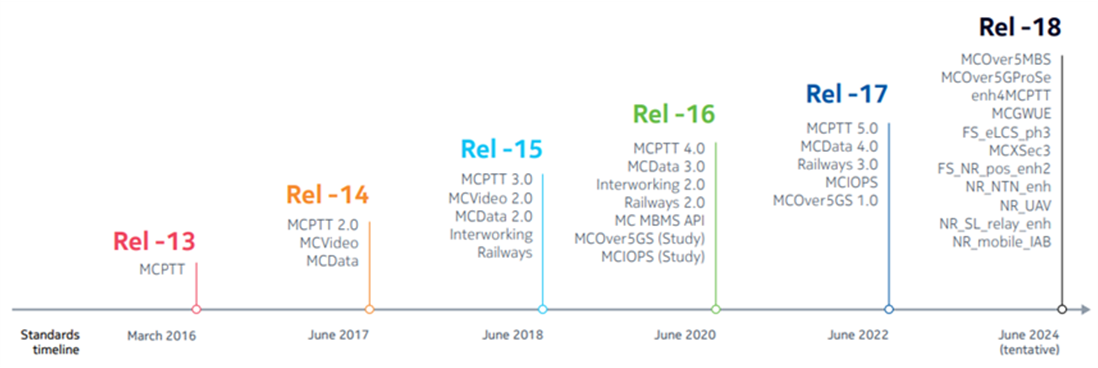Recently, ABI Research wrote a research report taking a deep dive into the current public safety network environment. One of the main highlights was that, while 4G/Long Term Evolution (LTE) cellular broadband is efficient in public safety use cases, 5G is fast approaching the emergency services space. The superior positioning, latency, and reliability of a 5G network will enable emergency services and emergency response teams to work more efficiently, gather better situational awareness, and accomplish the ultimate goal—save lives by reducing response times.
What Is a Public Safety Network?
A public safety broadband network is an organized web of communication channels dedicated to public safety authorities. These services enhance the capabilities of first responders, such as firefighters, paramedics, and police officers. Emergency response agencies use the cellular broadband network for gathering and analyzing critical information, such as image processing, file uploads, real-time video feeds, and more. In the event of a crisis, emergency services need a communication network that is quick and will not suffer from network congestion. A public safety network running on 4G/LTE must be able to offer mission-critical applications like:
- High network availability
- High network reliability
- High network performance
- High network security
4G LTE Nationwide Public Safety Networks
The majority of currently available public safety solutions run on 4G/LTE. Some modern use cases for LTE in public safety include bodycams on officers, drone cameras, photo evidence, remote diagnostics, remote-controlled drones, and connected wearables. The 3rd Generation Partnership Project (3GPP) Release 15 and sooner, on which 4G solutions are based, provides a wide array of benefits for public safety. Some of the LTE-supported features pointed out in last year’s report are:
- Enhanced features to group communications for Mission-Critical Push-to-Talk (MCPTT)
- Status alerts for data connections stemming from Mission-Critical Data (MCData) (e.g., low battery)
- Interworking, which connects both MCPTT and MCData services to a Land Mobile Radio (LMR)
- Enhancements in Evolved Multimedia Broadcast Multicast Services (eMBMS), such as multi-server bearer coordination, Forward Error Correction (FEC), and event notifications (e.g., cell fails to allocate resources)
Shifting from LTE to 5G Public Safety Networks
As useful as 4G/LTE broadband is for public safety, it’s clear that public safety networks of the not-so-distant future will drop LTE for standalone 5G, with New Radio (NR) as the radio interface. For example, AT&T has plans to eventually upgrade FirstNet to 5G and offers 5G technology for public safety in roughly 100 markets. Moreover, Ericsson and Nokia allow public safety broadband networks to be built on 5G, in addition to LTE. In the case of the latter, Nokia’s Future X architecture leverages data from connected sensors, people, vehicles, video cameras, and monitors. Further, emergency response teams can access 5G in even the most extreme conditions.
Migrating a public safety broadband network from LTE to 5G will provide emergency services with lower network latency, greater reliability, real-time drone control, and improved emergency services efficiency. 5G-supported devices will also have clearer imagery and video quality—key aspects in mission-critical situations.
The firure below from Nokia lists some of the misison-critical features that have been introduced through the various 3GPP releases.

5G Release 16 Positioning Mechanisms for Safety Operators
3GPP Release 16 introduces new mobile technologies for 5G public safety, in addition to the enhancements of existing 4G/LTE capabilities. For example, Ultra-Reliable Low Latency Communication (URLLC), a technology expected to gain some traction in the industrial sector, enables applications like remote control of robots and drones in dangerous situations or remote surgeries.
Another 5G technology that can benefit public safety networks is multi-cell Round Trip Time (RTT). Multi-cell RTT uses UL-SES and DL-PRS measures to estimate where a User Equipment (UE) is located.
Moreover, unlike LTE, a 5G-supported public safety network allows the UE or end terminal to calculate its own location without having to put further strain on network traffic capacity.
Other technological leaps expected in safety networks include Enhanced Mobile Broadband (eMBB) and Massive Machine Type Communications (mMTC). Using eMBB, safety operators can execute high-bandwidth applications, such as Augmented Reality (AR) for critical care or using Artificial Intelligence (AI) for camera monitoring/surveillance. At the same time, mMTC makes it possible for authorities/governments to install a considerable number of sensors that detect dangerous activities.
As impressive as 3GPP Release 16 is for 5G public safety systems, Release 17 and Release 18 will push things even further.
What Will 3GPP Release 17 and Release 18 Mean for 5G Public Safety Networks?
3GPP Release 17 and Release 18 will introduce far superior positioning technologies for first responders and emergency services. In fact, a recent survey conducted by ABI Research found that 56% of the decision makers in the main Real-Time Location System (RTLS) verticals stated that 5G positioning was the most sought-after RTLS technology. In the industry sector, which heavily influences the public safety space, 5G positioning is expected to arrive in 2023. Besides improving position accuracy and latency, 3GPP Release 17 will also enhance GNSS integrity and reduce timing delay errors.
3GPP Release 18 will arrive around the same time as 5G-Advanced, around 2025. In addition to extending NR position support to low-cost devices and further building upon positioning capabilities, nationwide public safety networks will be able to possibly leverage Sidelink. As mentioned in the whitepaper, Is The Industry—And The World—Ready For 5G Advanced?, Sidelink is a crucial part of Device-to-Device (D2D) communication.
Benefits of 5G for Public Safety
Carrying over to real-world use cases, a 5G-supported public safety network strengthens three key areas: situational awareness, network reliability, and traffic prioritization.
- Situational awareness is critical in emergency situations and 5G greatly improves a first responder's ability to assess a variety of scenarios. Leveraging antenna rays and beamforming features of Massive Multiple Input, Multiple Output (mMIMO) and Millimeter Wave (mmWave), 5G positioning is laser-accurate. Furthermore, Unmanned Aerial Vehicles (UAVs) that are flexible and deployable, as well as cells with Integrated Access Backhaul (IAB), can provide positioning metrics that are more accurate than previously achieved. These capabilities have clear value for rescue operations, for instance.
- Network reliability is strengthened through the deployment of (IAB), Sidelink, and Enhanced Mobile Broadband (eMBB). While IAB extends public safety broadband coverage into secluded locations, Sidelink—under 3GPP Release 17—expands network coverage for D2D communication, notably UE-to-UE relay configuration. While eMBMS was supported by LTE, 3GPP Release 17 takes first responder group communication to another level. eMBMS, originally used for providing broadcast TV to devices over a network, will improve reliability through features like multicast transmission. Multicast transmission, when combined with Hybrid Automatic Repeat Request (HARQ), can vastly improve spectral efficiency (maximum number of bits of data each user can receive without sacrificing Quality of Service (QoS)). Finally, the Release 17 framework will let safety operators/emergency services dynamically switch between unicast and multicast transmission. In turn, this supports smaller groups more efficiently.
- Traffic prioritization essentially refers to eliminating network congestion on shared public networks. The 5G feature that makes this possible for nationwide public safety networks is Unified Access Control (UAC), which was standardized in 3GPP Release 15. This traffic management algorithm prohibits conventional users from accessing the network if there is heavy network saturation. That way, if there’s an emergency (e.g., fire, health issue, or violence), first responders will have prioritized access. The UAC algorithm decides which users can and cannot enter the network by checking the Broadcast System Information (BSI) provided by the network and service information priority kept in the Universal Subscriber Identity Module (USIM). As soon as the UE is connected, the network then solicits QoS, priority, and preemption parameters—influencing the Radio Access Network (RAN) scheduler’s mission-critical traffic prioritization.
Preparing for the Evolution from 4G/LTE to 5G
For authorities/governments with plans for a public safety network, 4G/LTE cellular solutions provide a safe passage to a 5G upgrade; no reason to delay projects. ABI Research sees 2025 as the year when full standalone 5G networks are possibly deployed. This forecast presumes that 5G coverage becomes available nationwide using low, mid, and high-band frequencies.
There’s a lot that must be accounted for before green lighting a project as it relates to public safety systems. For example, which Mobile Network Operators (MNOs) show the greatest interest in this area? How will 5G fit into your budget? And will you deploy a private, shared, or commercial model? Surrounding yourself with experts in emergency services/first responder operations and their technical requirements is the first crucial step. Then there’s the problem of poor indoor coverage with 5G. ABI Research recommends a strong focus on indoor solutions, such as small cell sites.
While the public safety networks of today and the next few years may be fueled by 4G/LTE, infrastructure vendors can’t get caught sleeping on 5G. Indeed, public safety authorities/governments, like we’re seeing in industrial sectors, are only growing in the number of devices they use in day-to-day operations. Therefore, network upgrades are going to be due soon. As 5G coverage goes nationwide, vendors better have mission-critical solutions, tailored to the public safety domain, in place.
To learn more about the research services ABI Research offers, contact our sales team. A representative will walk you through our process, our technology focus areas, consulting opportunities, and custom research possibilities.



